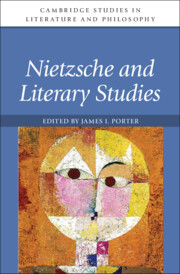Book contents
- Nietzsche and Literary Studies
- Cambridge Studies in Literature and Philosophy
- Nietzsche and Literary Studies
- Copyright page
- Contents
- Contributors
- Abbreviations
- Introduction
- 1 Heraclitus’ Clarity
- 2 Ariadne, or the Mediation of the Image
- 3 Nietzsche’s Centaurs
- 4 Nietzsche on the Task of the Poets in His Middle Writings
- 5 Some Images in Nietzsche’s Zarathustra
- 6 Nietzsche Ludens
- 7 Nietzsche and French Literature from the End of the Nineteenth Century to 1914
- 8 Ecce Mann
- 9 Plant Imaginaries and Human Existence in Nietzsche and Sartre
- 10 The Resources of the Figure
- 11 Nietzsche and Jewish Survival between Sarah Kofman and Jacques Derrida
- Editions and Translations of Nietzsche’s Works
- References
- Index
6 - Nietzsche Ludens
Subversions of Literature and Philosophy in the Later Writings
Published online by Cambridge University Press: 03 May 2024
- Nietzsche and Literary Studies
- Cambridge Studies in Literature and Philosophy
- Nietzsche and Literary Studies
- Copyright page
- Contents
- Contributors
- Abbreviations
- Introduction
- 1 Heraclitus’ Clarity
- 2 Ariadne, or the Mediation of the Image
- 3 Nietzsche’s Centaurs
- 4 Nietzsche on the Task of the Poets in His Middle Writings
- 5 Some Images in Nietzsche’s Zarathustra
- 6 Nietzsche Ludens
- 7 Nietzsche and French Literature from the End of the Nineteenth Century to 1914
- 8 Ecce Mann
- 9 Plant Imaginaries and Human Existence in Nietzsche and Sartre
- 10 The Resources of the Figure
- 11 Nietzsche and Jewish Survival between Sarah Kofman and Jacques Derrida
- Editions and Translations of Nietzsche’s Works
- References
- Index
Summary
This chapter explores the interplay of voices, poses, and masks that mark all of Nietzsche’s writings, but especially his later writings. His models are the ancient Cynics and “Lui,” the titular hero of Diderot’s satirical dialogue, Le Neveu de Rameau. A latter-day Cynic, Lui is a pantomime artist who uses physical and vocal mimicry to expose social hypocrisy through a shameless display of parrhēsia. Both Lui and the Cynics, literary artifacts themselves, explore philosophical problems in a performative mode that is hostile to conventions of all kinds, including those that govern literature and philosophy. Nietzsche follows suit with his own polyphonic and multi-gestural style of presentation, now directed at a late nineteenth-century audience. A self-conscious poseur and master of the falsetto, Nietzsche is supremely aware of his ability to trigger and lay bare his contemporaries’ ideas, fantasies, and fears by giving voice to them, not least by “sampling” them through a kind of theatrical extroversion of roles that are even today routinely mistaken for his own. A cultural pathologist whose primary object is the material of cultural fantasy itself, Nietzsche is ultimately concerned to critique the conventions that produce the very categories of literature and philosophy.
- Type
- Chapter
- Information
- Nietzsche and Literary Studies , pp. 142 - 165Publisher: Cambridge University PressPrint publication year: 2024

